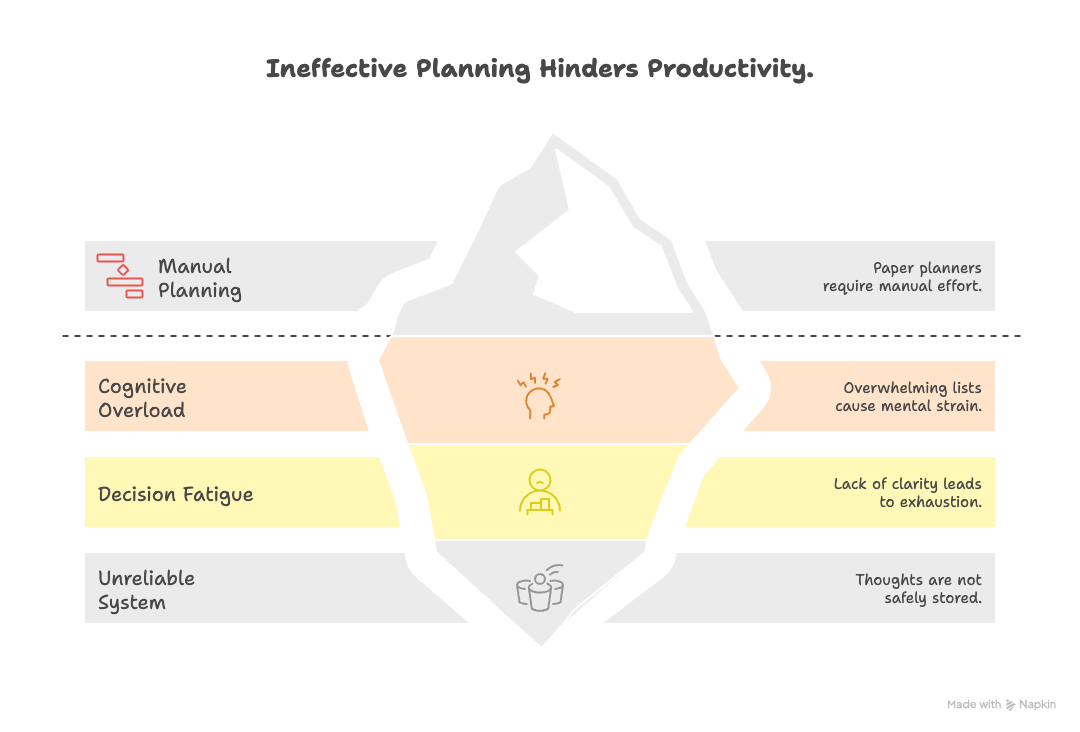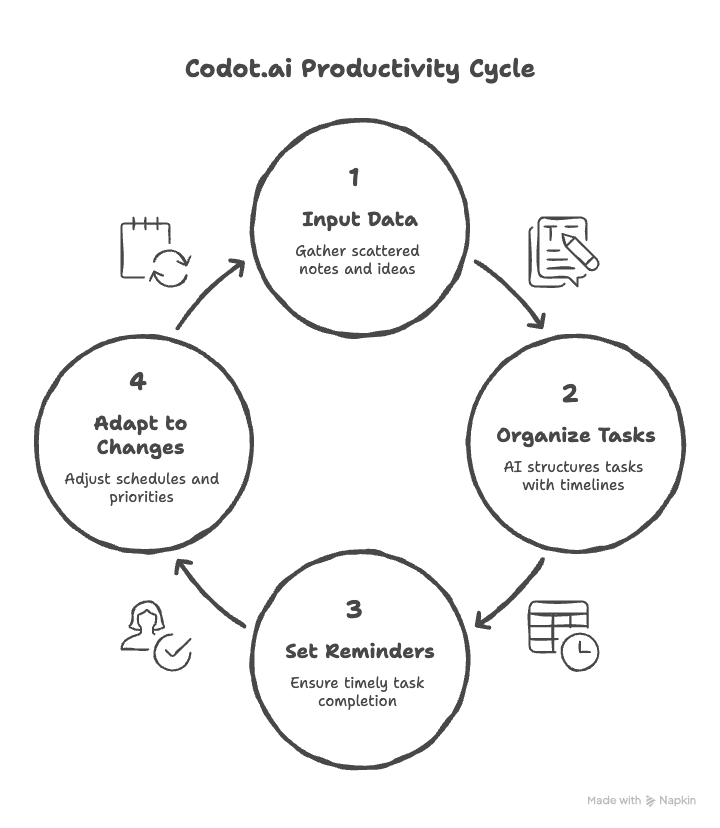Introduction
If you’ve ever bought a shiny new planner, filled out the first few pages with enthusiasm, and then abandoned it within weeks… you’re not alone.
For people with ADHD, the search for the best ADHD planner often feels like chasing a mirage. Traditional planners promise order, but they rarely address the real challenges: executive dysfunction, time blindness, decision paralysis, and the dopamine crash that follows the “new planner high.”
The truth? There is no one-size-fits-all “perfect” planner. What works is a system that adapts to your brain — not the other way around. And that’s where AI tools like codot.ai come in, offering a new kind of external support: a patient, non-judgmental assistant that helps you offload mental clutter and stay on track at work.
In this guide, we’ll break down:
-
The real reasons ADHD planners fail
-
The core principles behind ADHD-friendly planning systems
-
Why AI may finally be the solution ADHD brains have been waiting for
-
How codot.ai turns chaotic workdays into clear, structured plans
Finding the Best ADHD Planner: Why Work Feels Harder Than It Should
The Hidden Challenge — Executive Dysfunction
The ADHD brain struggles with working memory, task initiation, and prioritization.
Imagine opening your laptop on a Monday morning and thinking: “What should I do first?” That simple question, repeated dozens of times a day, drains energy and causes mental paralysis.

A good planner should act as external scaffolding:
-
Offloading thoughts into a safe, reliable system
-
Breaking overwhelming lists into smaller, doable steps
-
Providing a clear next action to reduce decision fatigue
-
But paper planners and even most apps fail here — because they require you to manually do the heavy lifting.
Time Blindness and Missed Deadlines
If you’ve ever underestimated how long a project would take (and then scrambled at the last minute), you’ve experienced time blindness.
ADHD brains often see time as just “now” or “not now.” Without external cues, deadlines sneak up unexpectedly.
That’s why effective ADHD planners use strategies like:
-
Time blocking (assigning realistic chunks of time to tasks)
-
Visual timers that make time tangible
-
Buffer time to absorb delays
Again, most planners leave this burden on the user — setting timers, creating schedules, adjusting calendars. And that’s where AI changes the game.
Why Motivation Crashes (a.k.a. The “New Planner High”)
ADHD brains run on interest-based motivation. A fresh, colorful planner can spark dopamine — but when novelty fades, so does usage.
That’s why gamified tools (like Habitica or Finch) work better than blank notebooks: they reward consistent action.
But even gamified planners eventually require effort that can feel unsustainable. What’s missing? A tool that doesn’t just remind you but actually helps you do the work of planning itself.
he Principles of the Best ADHD Planner
Across paper, digital, and hybrid systems, ADHD-friendly planning tools share four principles:
1. Simplicity and Visual Clarity
Busy layouts = instant overwhelm. The best planners use clean design and visual cues to calm the brain.
2. Flexibility and Forgiveness
Missed a week? A rigid planner feels like failure. ADHD-friendly planners allow resets without guilt — think undated pages or customizable apps.
3. External Scaffolding
A planner must serve as a “second brain” — catching tasks before they vanish from working memory.
4. Brain Dump Capability
ADHD minds are noisy. Tools that make it easy to capture thoughts quickly (voice notes, fast typing, or freeform writing) are essential.
Overwhelmed at Work?
Discover how codot.ai helps ADHD brains stay focused, organized, and stress-free — without the chaos.
Try codot.ai FreeWhy AI Is the Future of ADHD Planning
From Planner to Co-Pilot
AI tools transform the role of the planner. Instead of you doing all the structuring, an AI can:
-
Turn a messy brain dump into organized tasks
-
Estimate how long things will take (combatting time blindness)
-
Auto-prioritize based on deadlines and importance
-
Adjust schedules dynamically when things change
That means you stop being the overwhelmed “organizer” and start acting like the strategist of your own life.
Emotional Support Matters Too
ADHD challenges aren’t just logistical — they’re emotional. The cycle of forgetting, falling behind, and feeling shame is exhausting.
Here’s where AI offers something radical: it’s non-judgmental and endlessly patient. You can ask it the same question 10 times, and it will never roll its eyes. It can even help you reframe frustrations or talk through an emotional block before a meeting.
For ADHD workers, that combination of practical structure + emotional scaffolding is powerful.
How codot.ai Becomes the Best ADHD Planner for Work
So how does codot.ai fit into all this?
Designed as Your Second Brain

Unlike static planners, codot.ai integrates directly into your workflow. Imagine this:
You dump your scattered notes, emails, and half-finished ideas into codot.ai.
The AI organizes them into clear next steps with realistic timelines.
It sets reminders so nothing slips through the cracks.
It adapts when your schedule changes, re-prioritizing automatically.
Suddenly, the question “What should I do next?” disappears — because codot.ai already has the answer waiting.
Tackling ADHD’s Core Work Struggles
-
Executive Dysfunction: Codot.ai breaks projects into small, doable tasks.
-
Time Blindness: It creates time-blocked schedules with built-in buffer time.
-
Decision Paralysis: Instead of endless lists, you see one clear next action.
-
Motivation Drop-Off: The app gives feedback loops and reminders that keep you engaged.
-
Emotional Regulation: Codot.ai doubles as a safe space to process frustrations before they derail your workday.
It’s not just a planner — it’s a personalized cognitive assistant.
Ready to see how codot.ai can help?
Stay focused, organized, and confident at work.
Give your ADHD brain the second brain it deserves.
Choosing the Best ADHD Planner for You
So, is codot.ai the only option? No. Physical planners like Planner Pad or digital tools like Sunsama and Notion all have their strengths.
But if you want a future-proof ADHD planner for work, consider this checklist:
✅ Does it reduce decision fatigue?
✅ Does it adapt when your schedule changes?
✅ Does it externalize time and tasks clearly?
✅ Does it support emotional as well as logistical needs?
On all four counts, AI-powered planners like codot.ai stand out.
Conclusion: Your Next Step
The best ADHD planner isn’t about pages or apps — it’s about creating a system that actually works with your brain.
Traditional planners fail because they leave too much burden on you. But AI assistants like codot.ai finally shift that load, turning chaos into clarity and stress into strategy.
👉 Ready to see how codot.ai can help you stay focused, organized, and confident at work? [Try codot.ai today] and give your ADHD brain the second brain it deserves.
FAQ
Q1: What exactly is an AI personal assistant? An AI personal assistant is a software tool that uses artificial intelligence to automate tasks, manage schedules, analyze habits, and provide personalized recommendations—saving you time and boosting efficiency.
Q2: How is an AI assistant different from Siri or Alexa? While Siri or Alexa focus on voice commands and smart home tasks, AI assistants like Codot.ai are designed for productivity, scheduling, and deep work support, not just quick answers.
Q3: Is my data safe with an AI assistant? Privacy is a top concern. Tools like Codot.ai are built with privacy-first design, ensuring your data stays secure and confidential.
Q4: Do I need technical skills to use Codot.ai? Not at all. Codot.ai is designed to be intuitive—you can use natural language commands like “Schedule a meeting with John tomorrow at 2 PM” and it just works.
Q5: Will AI assistants replace jobs? AI assistants aren’t here to replace you—they’re here to remove repetitive, low-value tasks so you can focus on creativity, strategy, and growth.